Clear and consistent labeling that follows the Hazard Communication Standard is required in all University of Washington facilities including laboratories, shops, clinics, and other locations where personnel use, store, and transport chemicals. Chemical container labeling is one of the most effective and efficient ways to communicate hazard information to your coworkers and prevent accidents and injuries.
Chemical manufacturers are required to follow labeling requirements on the original container labels, and the downstream users of these chemicals are also required to follow labeling requirements when they transfer chemicals to secondary containers, or label chemical waste, UW-synthesized chemicals, and peroxide-forming chemicals.
The basic requirements for labeling chemicals are described in the sections below.
Original manufacturer labels
Labels on chemicals/products shipped from the manufacturer must be consistent with the Globally Harmonized System of Classification and Labeling of Chemicals (GHS) as required by Washington Administrative Code (WAC) 296-901-140.
- The label on an original chemical container must be legible and written in English.
- The label must include the chemical/product name (as shown on the SDS) and the manufacturer's name and address.
- Do not accept materials if the label is illegible or missing required information. (Refer to the sample original label below).
The Washington Administrative Code requires six elements on original labels:
- Product name
- Manufacturer's name and contact information
- Signal word (e.g., "danger" or "warning")
- Hazard statement(s) (e.g., "toxic if inhaled" or "combustible liquid")
- GHS pictogram(s)
- Precautionary statements (e.g., "Keep container tightly closed")
Avoid damaging the original container’s label, if possible. If a container label becomes damaged or is no longer readable, a new label must be prepared that includes the six required WAC elements to comply with GHS rules.
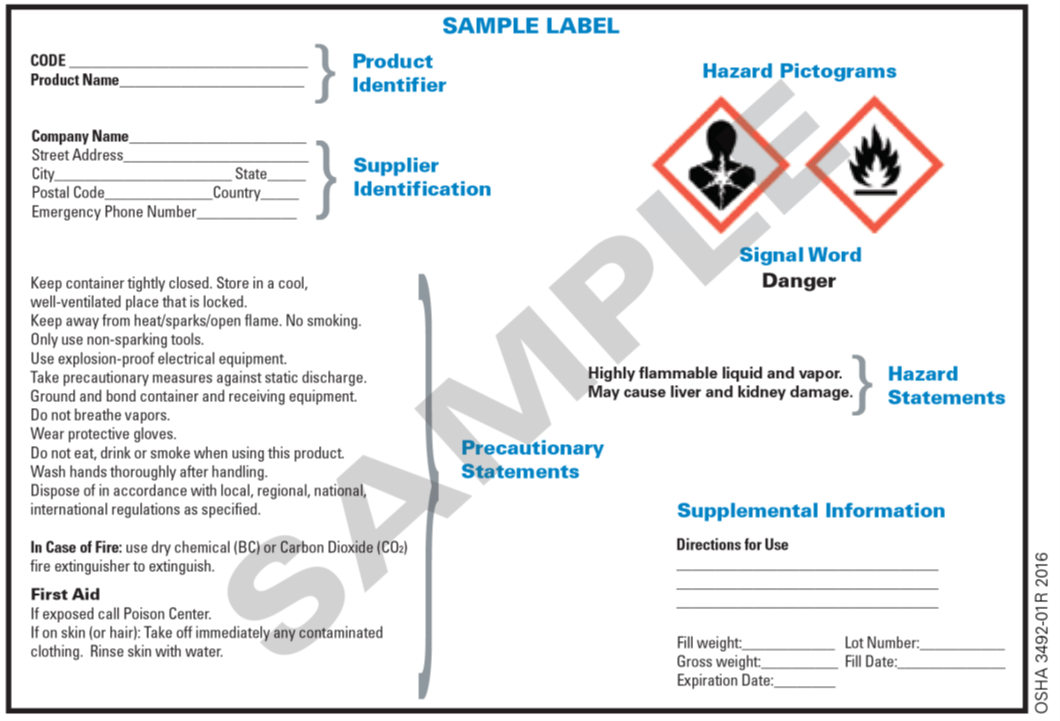
Read the Hazard Communication Standard for Labels and Pictograms for more information about original container label requirements.
Contact EH&S at 206.543.7388 or ehsdept@uw.edu for assistance in preparing a replacement label.
Secondary chemical container labels
Many University workplaces, including laboratories,  shops, and other facilities, purchase hazardous chemicals or products in large quantities, concentrates, or for mixing with other chemicals.
shops, and other facilities, purchase hazardous chemicals or products in large quantities, concentrates, or for mixing with other chemicals.
To use the chemical/product it may need to be transferred to a smaller or different “secondary” container (e.g., vials, flasks or bottles) for dilution, mixing, or general use.
If you transfer a hazardous chemical into a secondary container, the secondary container must be correctly labeled to ensure workers are readily aware of the contents and understand the hazards.
The Hazard Communication Standard requires secondary chemical container labels contain at least the following information:
- Identity of the contents (spell out chemical names)
- Signal word, if known or suspected (e.g., “danger”, “warning”)
- Hazards, if known or suspected (e.g., “flammable”, “corrosive”, “irritant”)
Words, symbols, pictures, Globally Harmonized System (GHS) pictograms, or a combination thereof, which provide at least general information regarding the chemical’s physical and health hazards can be used on the secondary container label. 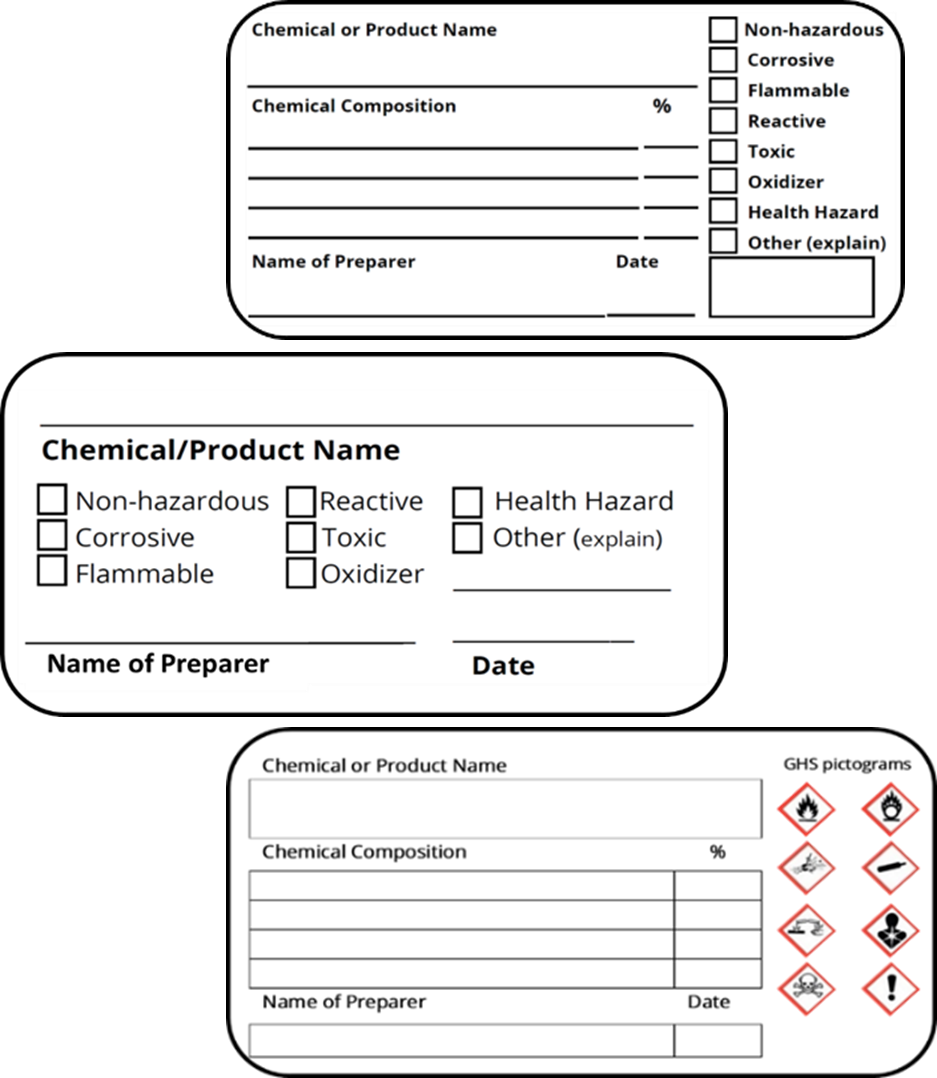
It is best practice to label the working solution with the name of the person preparing the solution and the date of preparation. Information about the signal word, hazards and the precautionary statements from the label, can be obtained from the SDS, but dilutions and reactions may change the hazards and their severity.
The label can include additional information, such as the composition of chemicals and percent concentration in the container, the date the chemical was received, the date a container was opened (if the chemical could degrade or react over time), the name of the person who prepared the chemical, or any other information useful for safe and efficient use.
Employees in the workplace must be able to readily understand the chemical and hazard information on a secondary container label. Abbreviations or acronyms should not be used on the labels.
Secondary container labels are not required if both of the following apply:
- The reagent, stock solution and chemicals mixed for use are under the direct control of the person who transferred or prepared it, and
- The container will be emptied during that person’s work shift.
EH&S has designed four secondary chemical container label templates for your use.
Download a template
Templates A and B are PDF fillable forms. Templates C and D are Word documents that show GHS pictograms.
Templates A, B and C are formatted for printing on Avery 5163 (2” x 4” label, 8 labels, 8½” x 11” page).
Note: New label template options A, B, C, D, replace older label template options 1, 2 and 3.
Resize a template
All templates can be resized to fit smaller containers.
To resize any of the Word or PDF label templates above to fit smaller containers, do the following:
- If the label template is a Word doc, fill in with the desired information, save it as a PDF, take a "snapshot" of the label in edit mode, paste it into a blank Word doc (this is now a picture), and resize at any corner of the image to desired size.
- If the label template is a PDF doc, fill in with the desired information, take a "snapshot" of the label in edit mode, paste it into a blank Word doc, and resize at any corner of the image to desired size.
- Fillable PDF or print blank
- Formatted for printing on Avery 5163 labels (2” x 4” label, 8 labels/ 8 ½” x 11” page)
Label A shows: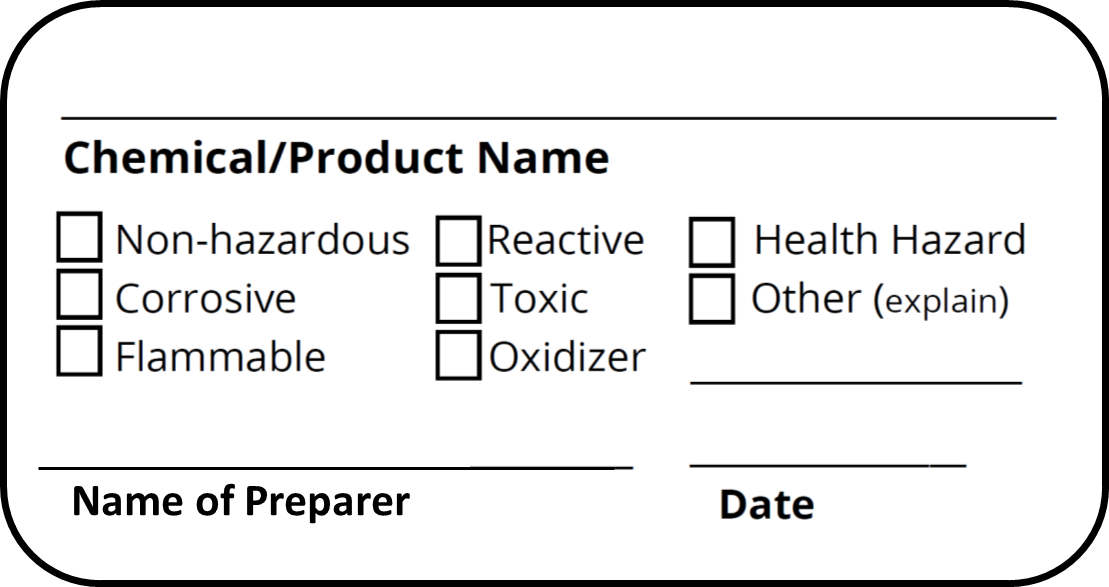
- Chemical/product name
- Hazard check boxes
- Name of preparer and date
- Fillable PDF or print blank
- Formatted for printing on Avery 5163 labels
Label B shows:
- Chemical/product name
- Hazard check boxes
- Chemical composition
- Name of preparer and date
- Fillable Word format or print blank
- Formatted for printing on Avery 5163 labels
- Select and delete pictograms not relevant
Label C shows: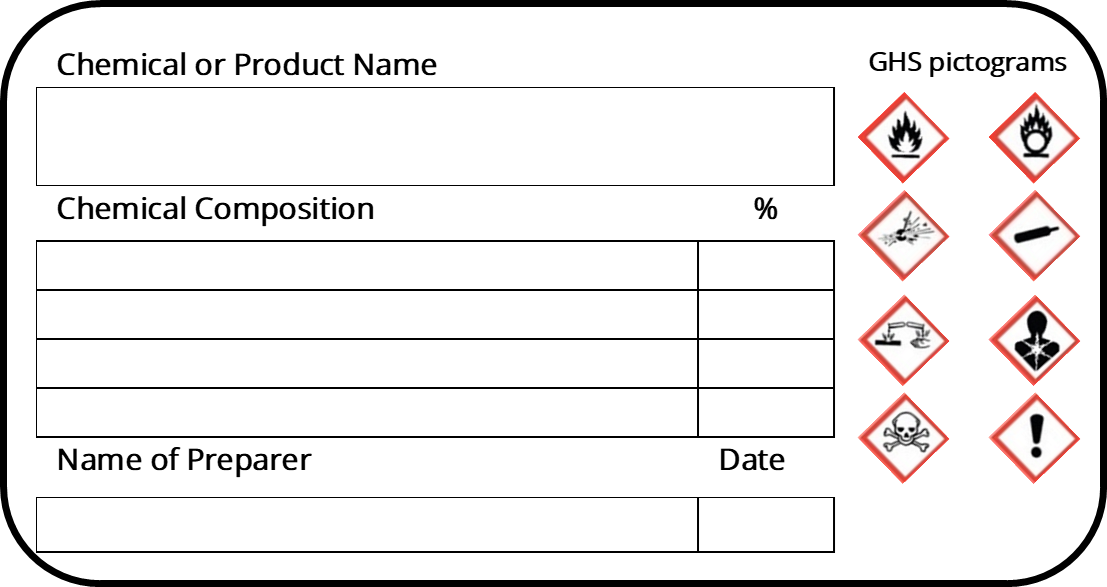
- Chemical/product name
- Chemical composition
- GHS hazard pictograms
- Name of preparer and date
Secondary Container Label D
- Word format with prompts to enter data
- Select and delete pictograms not relevant
- Adjust font size/spacing as needed
- Available in four sizes:
Label D shows:
- Chemical/product name
- GHS hazard pictograms
- GHS signal word
- GHS hazard statements
- Chemical composition
- Name of preparer and date
Credit: Label D design based on labels created by Washington State University EH&S Department.
Additional labeling instructions
As of July 28, 2023, Congress has allowed the statutory authority for the Chemical Facility Anti-Terrorism Standards program (6 CFR Part 27) to expire. EH&S is no longer responsible for reporting UW shipments of “chemicals of interest” to the U.S. Department of Homeland Security. Warning labels are no longer required for shipping chemicals of interest.
Follow the How to Label Chemical Waste Containers instructions when disposing of hazardous chemical waste. All hazardous chemical waste must be labeled with the UW Hazardous Waste label shown unless the material is still in its original manufacturer’s container. Containers need to be labeled as soon as waste begins to be accumulated in them. Hazardous waste labels are available for download from the Chemical Waste Disposal page.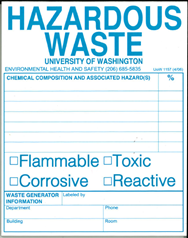
- Fill out the PDF label completely, including percentages of constituents, the hazards of the waste, and contact name.
- If you do not know the hazards of your chemical, use the MSDS of the chemical to determine what they are.
- Do not date the container or label.
- Deface or remove any original labels remaining on the container to avoid confusion about the identity of the waste.
Visit the Chemical Waste Disposal page for more information about pickup and disposal of hazardous chemical waste.
Containers with peroxide-forming chemicals, such as those listed below and discussed in Section 2 in the UW Laboratory Safety Manual or those with an SDS that states the chemical can form peroxides, must be labeled with the UW 1716 label shown and indicate the date the original container was first opened. These labels are available at the Chemistry Stockroom or through chmwaste@uw.edu.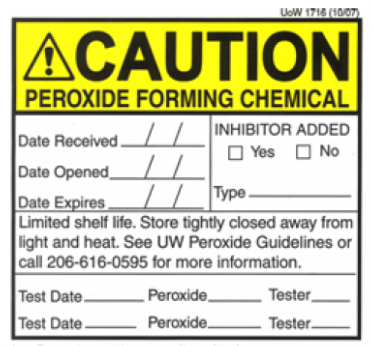
Refer to the EH&S Guidelines for Peroxide Forming Chemicals for additional information.
Special containers that may be too small for labels, installed into a process, or would become unusable for their intended purpose if labeled must still have their contents identified in some way. Use any labeling method that enables employees and visitors from other agencies, such as the fire department, to identify the chemicals and their hazards. Examples include tags, placards or signs identifying the materials and their hazards, color or numeric codes cross-referenced on a chart or room diagrams identifying locations of the chemicals and hazards. Contact EH&S to determine specific requirements.
Certain chemical-containing devices and equipment that must be labeled include:
- Piping and tubing containing hazardous chemicals
- Containers too small for labels
- Containment vessels installed into a process that may leak or be opened
- Containers that would become unusable if labeled with a marker or large adhesive-based label and that will hold chemicals beyond the end of the shift
- Wall outlet for a gas or liquid piped in from a remote reservoir
University researchers who synthesize a new chemical or product need to generate labels for containers holding the chemical/product that includes chemical information and any known or suspected hazards. If the researcher needs to ship the chemical/product they must develop an original (manufacturer) label as discussed above in the "Original manufacturer labels" section and a safety data sheet (SDS) for the synthesized chemical/product.
Refer to the Chemical Hazard Communication Program Manual for more information on developing a label and an SDS for a UW-synthesized chemical.